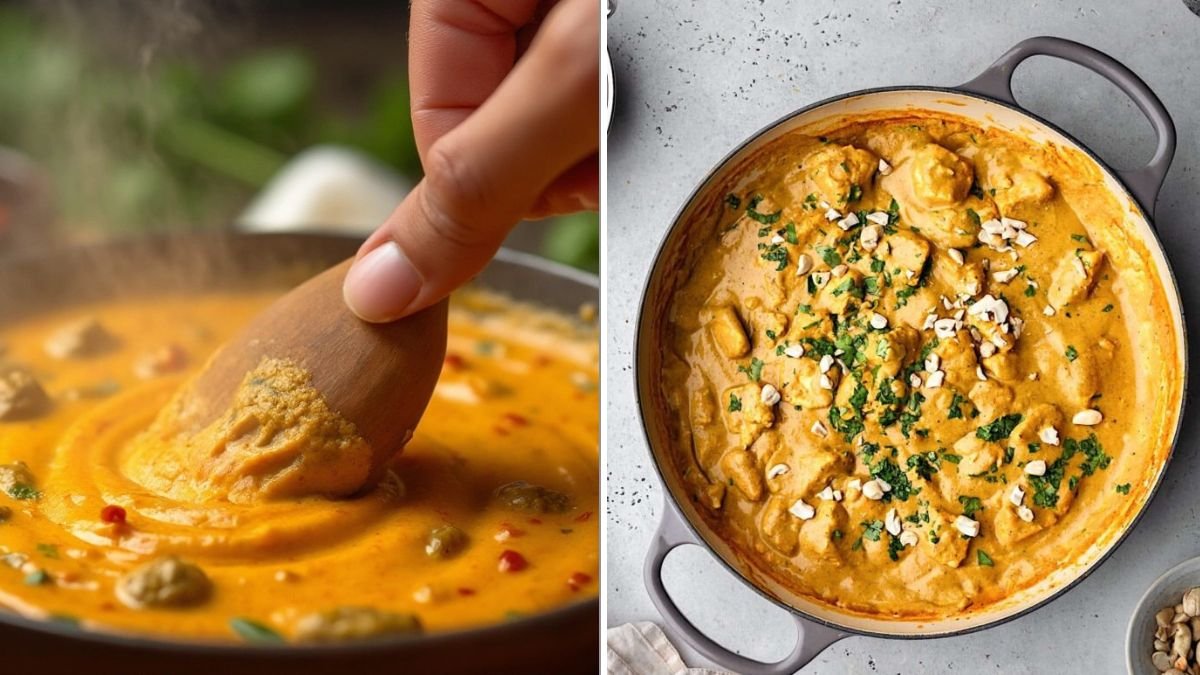Kerala-style Vegetable Kurma is a rich, aromatic, and mildly spiced curry that beautifully showcases the flavors of coconut, fresh vegetables, and authentic South Indian spices. Unlike typical North Indian kurmas, Kerala-style kurma emphasizes the natural sweetness of coconut and the subtle warmth of spices, making it a wholesome, comforting dish. Perfect for festive meals, family dinners, or even a special brunch, this curry pairs wonderfully with appam, parotta, steamed rice, or chapati. With a few simple steps, you can recreate this traditional Kerala delicacy at home.
This guide provides a 5-step approach to making Vegetable Kurma Kerala style, ensuring that your dish is both flavorful and authentic.
Ingredients You’ll Need
The key to an authentic Kerala-style vegetable kurma is using fresh vegetables, aromatic spices, and coconut in multiple forms—grated, paste, and milk—to achieve a rich, creamy texture.
Vegetables:
- 1 cup carrots, diced
- 1 cup beans, chopped
- 1/2 cup peas
- 1 cup cauliflower florets
- 1 medium potato, diced
- 1/2 cup beans or cabbage, chopped (optional)
For the Kurma Paste:
- 1/2 cup grated coconut (fresh or frozen)
- 2–3 green chilies (adjust to taste)
- 1-inch piece ginger, roughly chopped
- 2–3 cloves garlic
- 1 teaspoon fennel seeds
- 1/2 teaspoon black peppercorns
- 2 tablespoons roasted cashews (optional for richness)
For the Curry:
- 1 medium onion, finely sliced
- 2 tablespoons coconut oil (or vegetable oil)
- 1 sprig curry leaves
- 1 teaspoon mustard seeds
- 1/2 teaspoon turmeric powder
- Salt, to taste
- 1–2 cups water
- 1 cup coconut milk (full-fat or light)
- Fresh coriander leaves, for garnish
Optional:
- 1/4 teaspoon garam masala or Kerala-style garam masala for added aroma
Step 1: Preparing the Vegetables
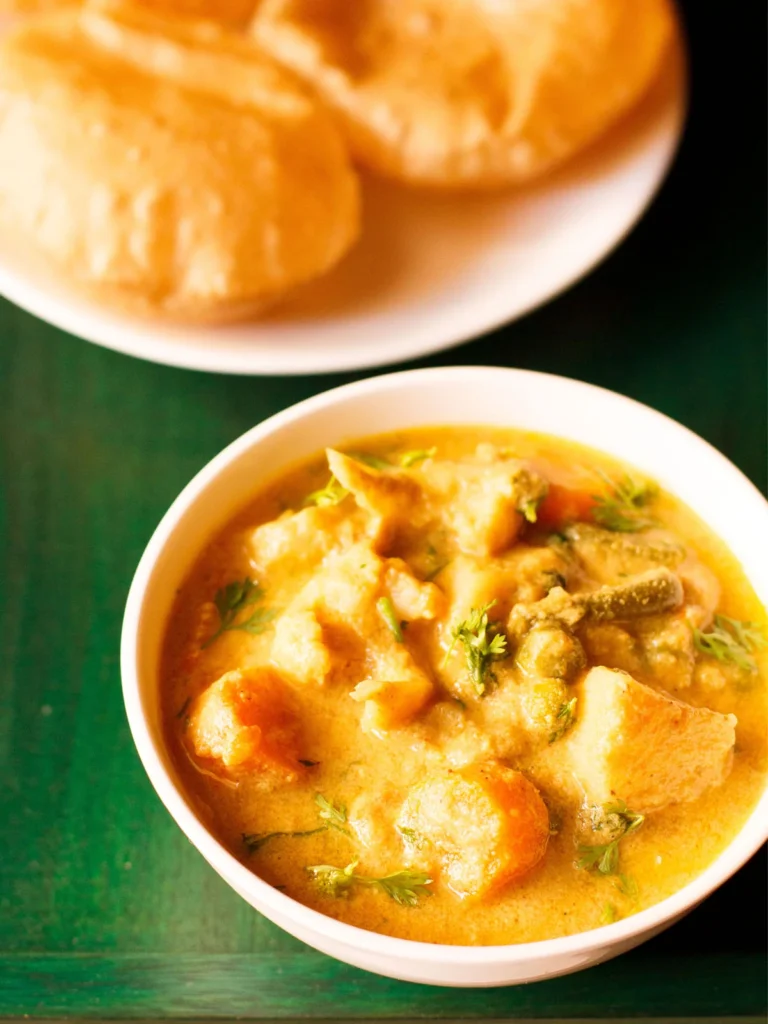
The foundation of a perfect Kerala-style vegetable kurma is the vegetables. Proper preparation ensures even cooking and vibrant flavors.
Instructions:
- Wash and peel the vegetables as needed.
- Dice vegetables into uniform pieces to ensure even cooking.
- Lightly blanch hard vegetables such as carrots, beans, and potatoes for 2–3 minutes to retain color and reduce cooking time.
- Keep softer vegetables like peas, cauliflower, or beans aside for later addition.
Tips:
- Seasonal vegetables like pumpkin or zucchini can also be added for variety.
- Avoid overcooking the vegetables to maintain a slightly crisp texture, which is characteristic of Kerala-style kurma.
Step 2: Making the Kerala-Style Kurma Paste
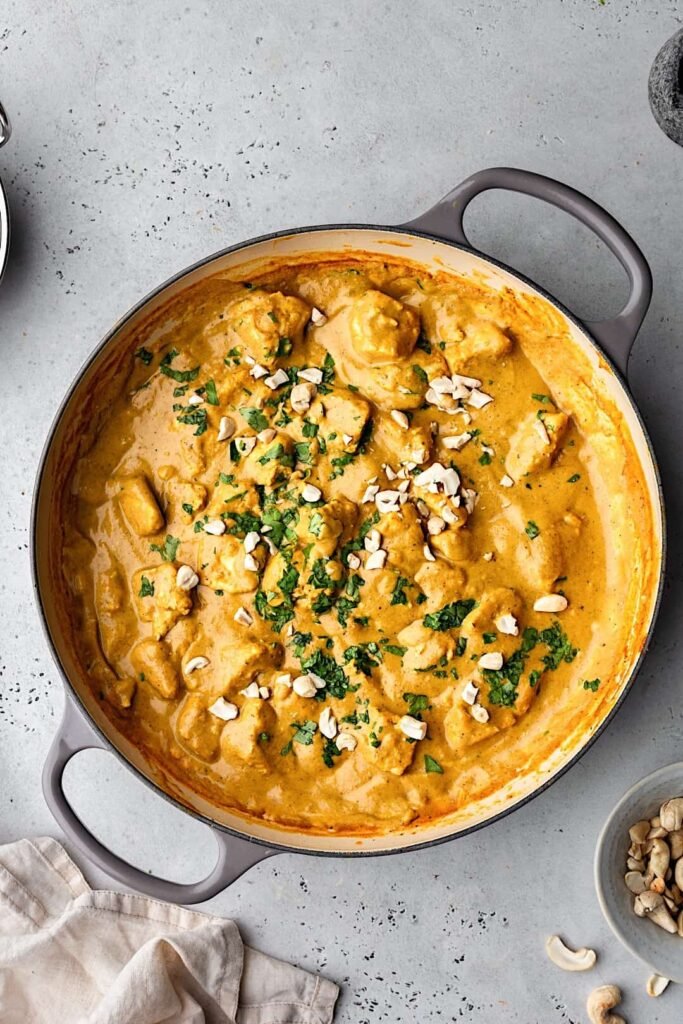
The kurma paste is the soul of this dish. Coconut, green chilies, spices, and ginger-garlic blend together to create a creamy, aromatic base.
Instructions:
- Combine grated coconut, green chilies, ginger, garlic, fennel seeds, black peppercorns, and roasted cashews in a blender.
- Add a small amount of water to form a smooth paste.
- Blend until creamy and free of lumps.
Tips:
- Fresh coconut provides the best flavor; however, frozen coconut works well when fresh isn’t available.
- The number of green chilies can be adjusted for desired heat.
Step 3: Preparing the Curry Base
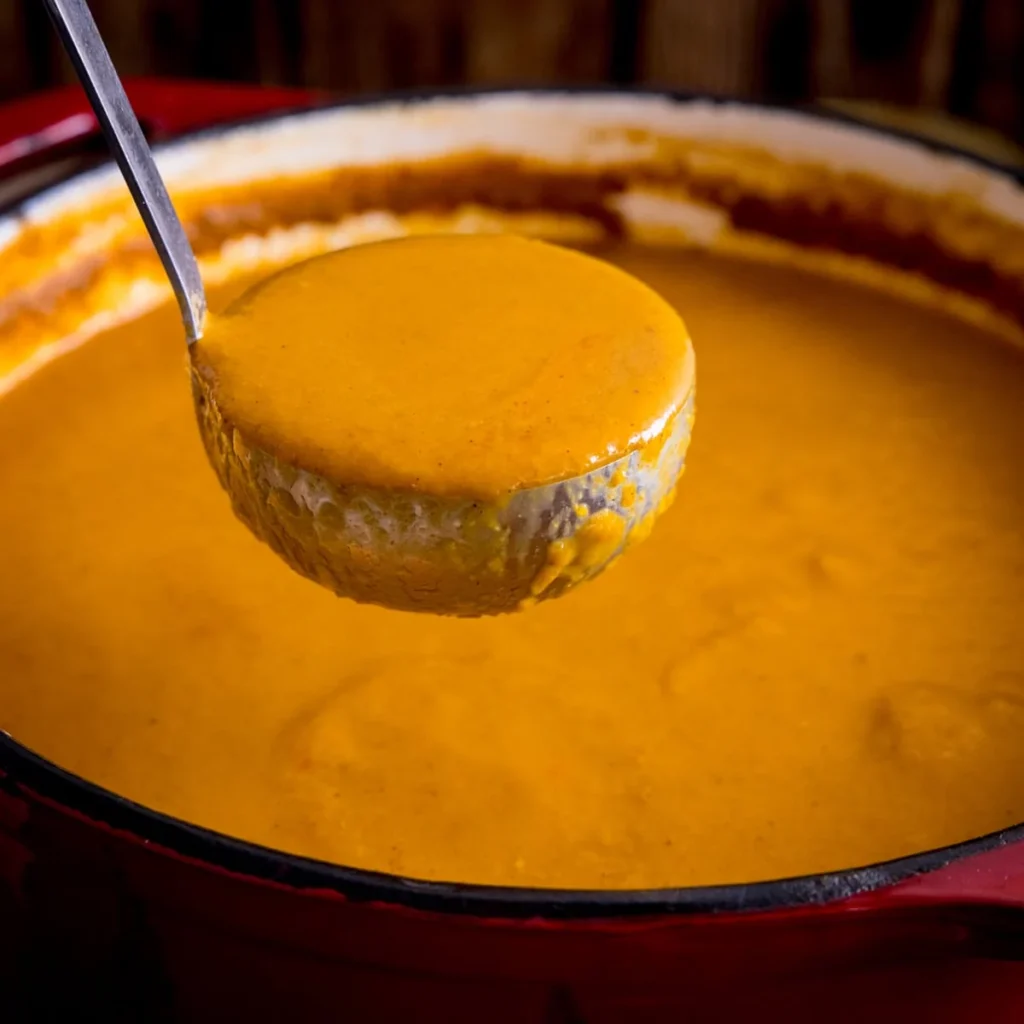
A flavorful curry base enhances the taste and aroma of the kurma.
Instructions:
- Heat 2 tablespoons of coconut oil in a heavy-bottomed pan over medium heat.
- Add mustard seeds and curry leaves; allow them to splutter.
- Sauté sliced onions until golden brown. This brings out natural sweetness and depth in the curry.
- Add turmeric powder and stir briefly.
- Pour in 1–2 cups of water and bring to a gentle boil.
Tips:
- Using coconut oil gives the dish an authentic Kerala flavor.
- Slow cooking onions ensures the natural sweetness complements the coconut paste.
Step 4: Cooking Vegetables with the Kurma Paste
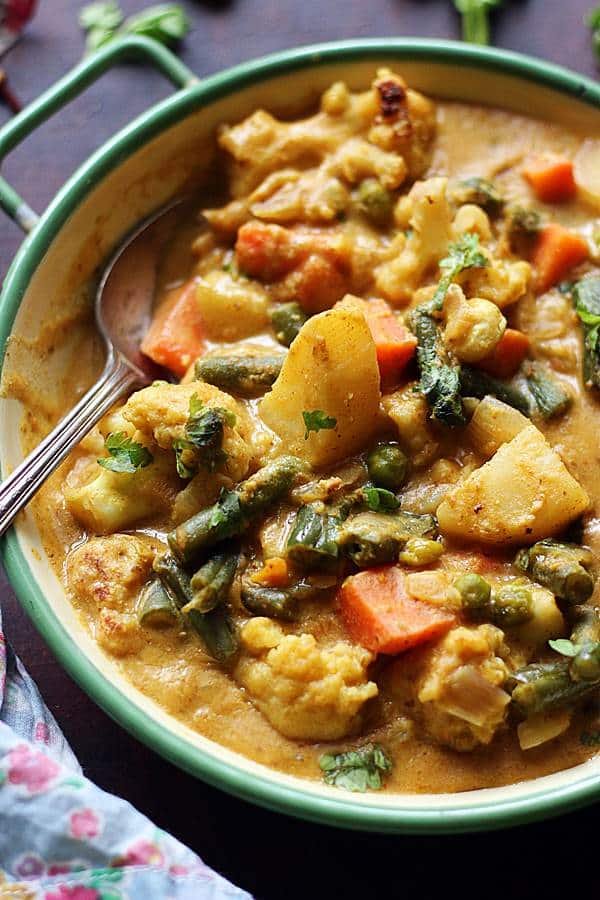
Now it’s time to combine the vegetables with the coconut paste for a rich, creamy curry.
Instructions:
- Add the blanched vegetables to the curry base and mix gently.
- Add the prepared kurma paste to the vegetables. Stir well to coat all vegetables evenly.
- Cover and cook on low heat for 5–7 minutes, allowing the vegetables to absorb the flavors.
- Add softer vegetables like peas or cauliflower during the last 3 minutes of cooking to prevent them from becoming mushy.
Tips:
- Keep the heat low to prevent the coconut paste from curdling.
- Stir gently to avoid breaking delicate vegetables like peas and cauliflower.
Step 5: Adding Coconut Milk and Final Touches
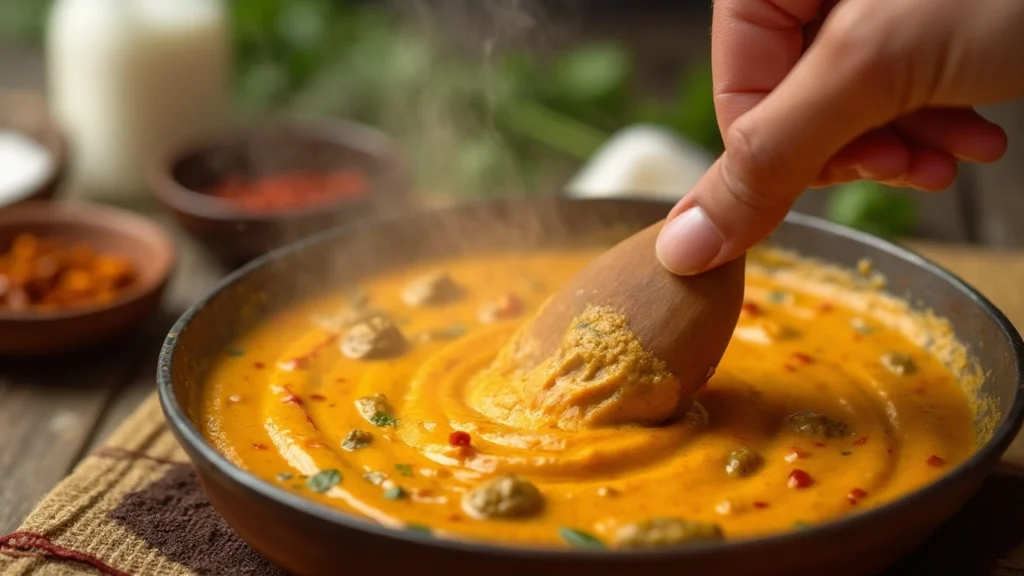
Coconut milk enriches the kurma and gives it a luxurious, creamy texture.
Instructions:
- Lower the heat and pour in coconut milk gradually while stirring to maintain a smooth, creamy consistency.
- Simmer for 3–5 minutes, allowing all flavors to meld.
- Taste and adjust salt, and add optional garam masala or a few curry leaves for added aroma.
- Garnish with freshly chopped coriander leaves.
- Serve hot with appam, parotta, steamed rice, or chapati.
Tips:
- Do not boil after adding coconut milk; high heat can split the milk and ruin the texture.
- For extra richness, a few roasted cashews on top add flavor and visual appeal.
Additional Tips for Authentic Kerala-Style Kurma
- Use Fresh Coconut Products: Fresh coconut and coconut milk are essential for an authentic taste and aroma.
- Balance Flavors: The mild sweetness of coconut should balance the subtle heat from green chilies.
- Vegetable Variety: You can add baby corn, zucchini, or even drumsticks (moringa) for a true South Indian touch.
- Cooking Technique: Slow simmering enhances flavors; avoid high heat to maintain the creamy texture.
- Oil Choice Matters: Coconut oil is traditional, but you can use a neutral oil if unavailable; it slightly changes the flavor profile.
Health Benefits of Kerala-Style Vegetable Kurma
- Nutrient-Rich: Packed with colorful vegetables providing vitamins, minerals, and antioxidants.
- Heart-Friendly: Coconut milk contains medium-chain triglycerides (MCTs), which may support metabolism.
- High Fiber: Vegetables and spices aid digestion and promote satiety.
- Low in Dairy: Coconut milk can replace cream or yogurt for a lighter, vegan-friendly alternative.
Why Kerala-Style Vegetable Kurma Is Special
Kerala-style Vegetable Kurma stands out due to its use of coconut in multiple forms, aromatic spices, and lightly cooked vegetables. It is a dish that is visually appealing, nutritionally balanced, and bursting with flavor. Unlike heavily spiced or cream-based curries, Kerala kurma is mildly spiced, letting the natural sweetness of coconut and vegetables shine through.
This dish is also extremely versatile, pairing beautifully with different types of Indian bread or rice and can be customized based on seasonal vegetables. Its creamy, aromatic, and wholesome nature makes it ideal for festive meals or special family dinners.
Conclusion
Cooking Kerala-style Vegetable Kurma at home is simple if you follow these five steps—preparing vegetables, making the coconut-spice paste, preparing the curry base, cooking vegetables with the paste, and adding coconut milk with final touches.
The secret to authentic taste lies in:
- Using fresh coconut and coconut milk
- Slow cooking onions for sweetness
- Gently simmering vegetables to maintain texture
- Balancing spices with the natural sweetness of coconut
This curry is a perfect blend of tradition, flavor, and nutrition, making it a must-try for anyone who loves South Indian cuisine. Serve it with appam, parotta, or steamed rice to enjoy a restaurant-quality Kerala meal right at home.
